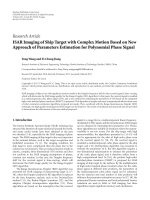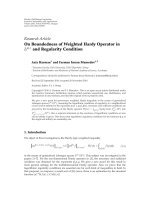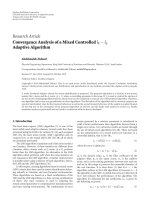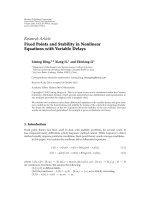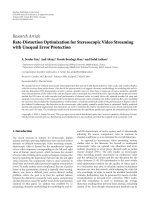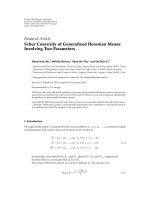Báo cáo hóa học: " Research Article L2 -Boundedness of Marcinkiewicz Integrals along Surfaces with Variable Kernels: Another Sufficient Condition" docx
Bạn đang xem bản rút gọn của tài liệu. Xem và tải ngay bản đầy đủ của tài liệu tại đây (556.23 KB, 14 trang )
Hindawi Publishing Corporation
Journal of Inequalities and Applications
Volume 2007, Article ID 26765, 14 pages
doi:10.1155/2007/26765
Research Article
L
2
-Boundedness of Marcinkiewicz Integrals along Surfaces with
Variable Kernels: Another Sufficient Condition
Qingying Xue and K
ˆ
oz
ˆ
o Yabuta
Received 18 December 2006; Accepted 23 April 2007
Recommended by Shusen Ding
We give the L
2
estimates for the Marcinkiewicz integral with rough variable kernels as-
sociated to surfaces. More precisely, we give some other sufficient conditions which are
different from the conditions known before to warrant that the L
2
-boundedness holds.
As corollaries of this result, we show that similar properties still hold for parametric
Littlewood-Paley area integral and parametric g
∗
λ
functions with rough variable kernels.
Some of the results are extensions of some known results.
Copyright © 2007 Q. Xue and K. Yabuta. This is an open access article distributed under
the Creative Commons Attribution License, which permits unrestricted use, distribution,
and reproduction in any medium, provided the original work is properly cited.
1. Introduction
Inordertostudytheellipticpartialdifferential equations of order two with variable coef-
ficients, Calder
´
on and Zygmund [3] defined and studied the L
2
-boundedness of singular
integral T with variable kernels. In 1980, Aguilera and Harboure [4]studiedtheproblem
of pointwise convergence of singular integral and the L
2
-bounds of Hardy-Littlewood
maximal function with variable kernels. In 2002, Tang and Yang [1]gavetheL
2
bound-
edness of the singular integrals with rough variable kernels associated to surfaces of the
form
{x = Φ(|y|)y
},wherey
= y/|y| for any y ∈R
n
\{0} (n ≥ 2). That is, they consid-
eredthevariableCalder
´
on-Zygmund singular integral operator T
Φ
defined by
T
Φ
( f )(x) = p.v.
R
n
k(x, y) f
x −Φ
|
y|
y
dy, (1.1)
and its truncated maximal operator T
∗
Φ
defined by
T
∗
Φ
( f )(x) = sup
ε>0
|y|>ε
k(x, y) f
x −Φ
|
y|
y
dy
, (1.2)
2 Journal of Inequalities and Applications
for f
∈ C
∞
0
(R
n
), where k(x, y) = Ω(x, y)/|y|
n
: R
n
× R
n
\{0}→R, Ω(x, y)ispositively
homogeneous in y of degree 0, namely Ω(x,λy)
= Ω(x, y)foranyλ>0, and
S
n−1
Ω(x, y
)dσ(y
) = 0fora.e.x ∈ R
n
, (1.3)
where S
n−1
is the unit sphere of R
n
equipped w ith Lebesgue measure dσ = dσ(x
).
They gave the following result.
Theorem 1.1 (see [1]). Suppose k(x, y) is as above a nd satisfies, for some q>2(n
−1)/n,
Ω
L
∞
×L
q
(S
n−1
)
= sup
x∈R
n
S
n−1
Ω(x, y
)
q
dσ(y
)
1/q
< ∞. (1.4)
Let Φ(t) be a nonnegative (or nonpositive) C
1
function on (0,∞) satisfying
(a) Φ is strictly increasing (or decreasing);
(b) Φ(t)/t
= C
2
Φ
(t)ϕ(t) for all t ∈ (0,∞), ϕ is defined on (0,∞) whichisamonotonic
and uniformly bounded function.
Then T
∗
Φ
is bounded on L
2
(R
n
) and T
Φ
canbeuniquelyextendedtobeaboundedoperator
on L
2
(R
n
).Moreover,forall f ∈ L
2
(R
n
),
T
Φ
( f )
2
≤ Cf
2
,
T
∗
Φ
2
≤ Cf
2
, (1.5)
where the constant C is independent of f .
On the other hand, as a related vector-valued singular integral with variable kernel, the
Marcinkiewicz integral with rough variable kernel associated with surfaces of the form
{x = Φ(|y|)y
} is considered. It is defined by
μ
Φ
Ω
( f )(x) =
∞
0
F
Ω,t
(x)
2
dt
t
3
1/2
, (1.6)
where
F
Ω,t
(x) =
|y|≤t
Ω(x, y)
|y|
n−1
f
x −Φ
|
y|
y
dy. (1.7)
If Φ(
|y|) =|y|,weputμ
Φ
Ω
= μ
Ω
.Thenμ
Ω
with convolution type of kernel is just the
Marcinkiewicz integral of higher dimension w hich was first defined and studied by Stein
[5] in 1958. Since then, many works have been done about this integral (see, e.g., [6–8]).
In 2005, Ding et al. [9]studiedtheL
2
boundednessoftheoperatorμ
Ω
.
Theorem 1.2 (see [9]). Suppose that Ω(x, y) is positively homogeneous in y of degree 0,
and satisfies (1.3)and(1.4)forsomeq>2(n
−1)/n. Then there is a constant C such that
μ
Ω
( f )
2
≤ Cf
2
, whe re the constant C is independent of f .
So, we have considered that it is natural to ask if the results in Theorem 1.1 still hold
or not for the Marcinkiewicz integral with rough variable kernels along surfaces, and got
in our paper [2] t he following answer.
Q. Xue and K. Yabuta 3
Theorem 1.3 (see [2]). Suppose that Ω(x, y) is positively homogeneous in y of degree 0,and
satisfies (1.3)and(1.4)forsomeq>2(n
−1)/n.LetΦ be a positive and strictly increasing
(or negative and decreasing) C
1
function and let it satisfy Φ(t)/t = Φ
(t)ϕ(t) for all t ∈
(0,∞),whereϕ is a function defined on (0,∞) and there exist two constants δ, M such that
0 <δ
≤|ϕ(t)|≤M.Supposemoreoverϕ satisfies one of the following conditions:
(i) tϕ
(t) is bounded;
(ii) ϕ is a monotonic function.
Then there is a constant C such that
μ
Φ
Ω
( f )
2
≤ Cf
2
, where constant C is independent
of f .
In this paper, we will give another sufficient condition, relating to a recent paper by
Al-Qassem [10].
Theorem 1.4. Suppose that Ω(x, y) is positively homogeneous in y of degree 0,andsatisfies
(1.3)and(1.4)forsomeq>2(n
−1)/n.LetΦ be a positive and monotonic (or negative and
monotonic) C
1
function on (0,∞) and let it satisfy the following c onditions:
(i) δ
≤|Φ(t)/(tΦ
(t))|≤M for some 0 <δ≤ M<∞;
(ii) Φ
(t) is monotonic on (0, ∞).
Then there is a constant C such that
μ
Φ
Ω
( f )
2
≤ Cf
2
, where constant C is independent
of f .
Remark 1.5. There is no including relationship between condition (ii) and conditions (i),
(ii) in Theorem 1.3, this can be seen from the example given in [2, Section 2 and Examples
2and3].
Remark 1.6. If Φ(t) is a positive and monotonic function on (0,
∞)andΦ
(t)ismono-
tonic, then the following (i) and (ii) are equivalent.
(i) δ
≤|Φ(t)/(tΦ
(t))|≤M (0 <t<∞)forsome0<δ≤M<∞;
(ii) η
≤ max{g(2t)/g(t), g(t)/g(2t)}≤L on (0,∞)forsome1<η≤ L<∞.
This can be checked by elementary consideration, using convexity or concavity.
Condition (ii) is used to give L
p
boundedness of Marcinkiewicz integ rals along sur-
faces with convolution type of kernel by Al-Qassem [10].
Furthermore, our results can be extended to the parametric Marcinkiewicz integrals,
parametric area integral, and parametric μ
∗
λ
function, which are defined by
μ
Φ,σ
Ω
( f )(x) =
∞
0
|y|≤t
Ω(x, y)
|y|
n−σ
f
x −Φ
|
y|
y
dy
2
dt
t
1+2σ
1/2
,
μ
Φ,σ
S
( f )(x) =
Γ(x)
1
t
σ
|z|<t
Ω(y,z)
|z|
n−σ
f
y −Φ
|
z|
z
dz
2
dydt
t
n+1
1/2
,
μ
∗,σ
λ,Φ
( f )(x) =
R
n+1
+
t
t + |x − y|
λn
1
t
σ
|z|<t
Ω(y,z)
|z|
n−σ
f
y −Φ
|
z|
z
dz
2
dydt
t
n+1
1/2
,
(1.8)
where Γ(x)
={(y, t) ∈ R
n+1
+
: |x − y| <t} and λ>1.
4 Journal of Inequalities and Applications
We get the following result.
Theorem 1.7. Let σ>0. Then Theorem 1.4 still holds for the parametric operators μ
Φ,σ
Ω
,
μ
Φ,σ
S
,andμ
∗,σ
λ,Φ
.
Throughout this paper, the letter C will denote a positive constant that may vary at
each occurrence but is independent of the essential variables.
2. Proof of Theorem 1.4
We begin with recalling a known lemma. This lemma can be obtained from [11, (2.19),
page 152], and [11, Theorem 3.10, page 158], see also [1].
Lemma 2.1 (see [11]). Let n
≥ 2, k ≥ 0,andletP(y) be a spherical harmonic of degree k.
Then
S
n−1
P(y
)e
−ix·y
dσ(y
) = (−i)
k
(2π)
n/2
J
n/2+ k−1
|
x|
|x|
n/2−1
P
x
|x|
. (2.1)
Thefirstpartofthenextlemmaisgivenin[2, page 372].
Lemma 2.2. (1) Let g(t) be a nonnegative (positive) and nondecreasing (strictly increasing)
function on (0,
∞) such that there exists ϕ(t) satisfying
g(t)
t
= g
(t)ϕ(t). (2.2)
If there exists δ>0 such that 0 <δ
≤ ϕ(t) on (0,∞), then [g
−1
(t)]
σ
/t
ε
is nondecreasing
(strictly increasing) on (0,
∞) for 0 <ε≤ σδ (0 <ε<σδ).Conversely,if[g
−1
(t)]
σ
/t
ε
is non-
decreasing (strictly increasing) for some ε>0, then ϕ(t)
≥ ε/σ (ϕ(t) >ε/σ).
(2) Let g(t) be a nonnegative (positive) and nonincreasing (strictly decreasing) function
on (0,
∞) such that there exists ϕ(t) satisfying
g(t)
t
= g
(t)ϕ(t). (2.3)
If t here exists δ>0 such that 0 <δ
≤−ϕ(t) on (0,∞), then [g
−1
(t)]
σ
t
ε
is non-increasing
(strictly decreasing) on (0,
∞) for 0 <ε≤ σδ (0 <ε<σδ).Conversely,if[g
−1
(t)]
σ
/t
ε
is non-
increasing (strictly decreasing) for some ε>0, then
−ϕ(t) ≥ ε/σ (−ϕ(t) >ε/σ).
One can prove this in an elementary calculation. Case (1) is given in [2, page 372], and
Case (2) is shown similarly. We also note that if ϕ(t)inLemma 2.2 is bounded (without
boundedness from below), it follows lim
t→0
g(t) = 0andlim
t→∞
g(t) = +∞ in Case (1),
and lim
t→0
g(t) = +∞ and lim
t→∞
g(t) = 0 in Case (2). (Cf. [12] for the proof.)
Below we give one example.
Example 2.3. Take a nondecreasing function ψ(t)
∈ C
∞
(R) satisfying 0 ≤ ψ(t) ≤ 1(t ∈
R
), ψ(t) = 0on(−∞,0), ψ(t) = 1on[1,∞), and 0 <ψ
(t) < 2(0<t<1). Set
ϕ(t)
=
1
5
2+ψ(t) −
∞
j=1
2
−j
ψ
2
2j
t −2
j
. (2.4)
Q. Xue and K. Yabuta 5
Then, we have 2/5
≤ ϕ(t) ≤ 3/5on(0,∞), 0 <ϕ
(t) = ψ
(t)/5 < 2/5(0<t<1), ϕ
(t) ≤ 0
(t
≥ 1), ϕ
(t) < 0(2
j
<t<2
j
+2
−2j
, j = 1,2, ) (hence ϕ(t) is not monotonic on (0,∞)),
and limsup
t→+∞
|tϕ
(t)|=+∞.Putg(t) = exp(
t
1
(ds/sϕ(s))). Then g(t) is positive and
increasing on (0,
∞), and g
(t) = g(t)/(tϕ(t)) (i.e., g(t)/t = g
(t)ϕ(t)), and g
(t) = (1 −
ϕ(t) −tϕ
(t))/(tϕ(t))
2
. By the definition of ϕ(t)wehave,for0<t<1
1
−ϕ(t) −tϕ
(t) ≥ 1 −
3
5
−tϕ
(t) >
2
5
−
2
5
= 0, (2.5)
and for t
≥ 1, because of ϕ
(t) ≤ 0(t ≥ 1)
1
−ϕ(t) −tϕ
(t) ≥ 1 −
3
5
=
2
5
. (2.6)
Hence g
(t) > 0on(0,∞), and so g
(t) is strictly increasing. This g(t) satisfies condi-
tions (i) and (ii) in Theorem 1.4.But,ϕ(t)
= g(t)/(tg
(t)) is not monotonic nor tϕ
(t)is
bounded.
Next, we prepare two more lemmas. Denote by J
ν
the Bessel function of order ν of the
first kind. T he following lemma is given by L. Lorch and P. Szego, the old version of this
type inequality is due to A. P. Calder
´
on and A. Zygmund.
Lemma 2.4 (see [13]). Suppose ν and λ satisfy ν
− λ>−1,and|ν| > 1/2, λ ≥−1/2 or
ν >
−1, λ ≥ 0.Then,
r
0
J
ν
(t)
t
λ
dt
≤
C
|ν|
λ
, for 0 <r<∞. (2.7)
Lemma 2.5 (see[4]). Suppose m
≥ 1 and λ>0. Then
1
r
r
0
J
m+λ
t
λ
dt
≤
C
m
λ+1
, for 0 <r<∞. (2.8)
Now we turn to the proof of Theorem 1.4.
Let Ᏼ
k
be the space of surface spherical harmonics of deg ree k on S
n−1
with dimension
D
k
. By the same argument as in [3], one can reduce the proof of Theorem 1.4 to the case
as follows:
f
∈ C
∞
0
, Ω(x, y
) =
k≥1
D
k
j=1
a
k, j
(x) Y
k, j
(y
) is a finite sum, (2.9)
where
{Y
k, j
} (k ≥ 1, j = 1,2, ,D
k
) denotes the complete system of normalized surface
spherical harmonics. Set
a
k
(x) =
D
k
j=1
a
k, j
(x)
2
1/2
, b
k, j
(x) =
a
k, j
(x)
a
k
(x)
. (2.10)
6 Journal of Inequalities and Applications
Then we get
D
k
j=1
b
2
k, j
(x) = 1, Ω(x, y
) =
k≥1
a
k
(x)
D
k
j=1
b
k, j
(x) Y
k, j
(y
). (2.11)
Note that if we take 0 <ε<1sufficiently close to 1, then by [3, (4.4), page 230] we have
k≥1
k
−ε
a
2
k
(x)
1/2
≤ CΩ
L
∞
(R
n
)×L
q
(S
n−1
)
=: CΩ. (2.12)
By H
¨
older’s inequality, the above estimates, and Fourier t ransform, we get
μ
Φ
Ω
( f )
2
2
=
R
n
∞
0
|y|≤t
k≥1
a
k
(x)
D
k
j=1
b
k, j
(x)
Y
k, j
(y
)
|y|
n−1
f
x −Φ
|
y|
y
dy
2
dt
t
3
dx
≤
R
n
k≥1
k
−ε
a
2
k
(x)
k≥1
k
ε
∞
0
D
k
j=1
b
2
k, j
(x)
×
D
k
j=1
|y|≤t
Y
k, j
(y
)
|y|
n−1
f
x −Φ
|
y|
y
dy
2
dt
t
3
dx
≤ CΩ
2
k≥1
k
ε
D
k
j=1
∞
0
R
n
|y|≤t
Y
k, j
(y
)
|y|
n−1
f
x −Φ
|
y|
y
dy
2
dx
dt
t
3
≤CΩ
2
k≥1
k
ε
D
k
j=1
∞
0
R
n
|y|≤t
Y
k, j
(y
)
|y|
n−1
f
·−
Φ
|
y|
y
dy
∧
(ξ)
2
dξ
dt
t
3
= CΩ
2
k≥1
k
ε
R
n
D
k
j=1
μ
Φ
Ω
Y
k, j
(ξ)
2
f (ξ)
2
dξ,
(2.13)
where
μ
Φ
Ω
Y
k, j
(ξ) =
∞
0
1
t
t
0
S
n−1
e
−iΦ(r)ξ·y
Y
k, j
(y
)dσ(y
)dr
2
dt
t
1/2
. (2.14)
So by Lemma 2.1, we only need to show
D
k
j=1
∞
0
1
t
t
0
J
n/2+ k−1
Φ(r)|ξ|
Φ(r)|ξ|
n/2−1
dr Y
k, j
(ξ
)
2
dt
t
≤ Ck
−2
. (2.15)
Denote
N
t
(ξ) =
1
t
t
0
J
n/2+ k−1
Φ(r)|ξ|
Φ(r)|ξ|
n/2−1
dr. (2.16)
In the sequel, we set ϕ(t)
= Φ(t)/(tΦ
(t)) and ν = n/2+k − 1. We note that
ρ/
|ξ|Φ
(Φ
−1
(ρ/|ξ|)) =ϕ(Φ
−1
(ρ/|ξ|))Φ
−1
(ρ/|ξ|).
Q. Xue and K. Yabuta 7
We will treat the following two cases. (A) Φ(t) is positive and increasing, and (B) Φ(t)
is positive and decreasing. We do not need to t reat the case where Φ(t)isnegative.
(A) We treat first the case where Φ(t) is positive and increasing. Setting ρ
= Φ(r)|ξ|,
we hav e
N
t
(ξ) =
1
t
Φ(t)|ξ|
0
J
n/2+ k−1
(ρ)
ρ
n/2−1
Φ
−1
ρ
|ξ|
dρ
|ξ|
=
1
t
Φ(t)|ξ|
0
J
n/2+ k−1
(ρ)
ρ
n/2−1
dρ
|ξ|Φ
Φ
−1
ρ/|ξ|
.
(2.17)
Setting s
= Φ(t)|ξ|,wehave
∞
0
N
t
(ξ)
2
dt
t
=
∞
0
ϕ
Φ
−1
s/|ξ|
Φ
−1
s/|ξ|
2
s
0
J
n/2+ k−1
(ρ)
ρ
n/2
dρ
|ξ|Φ
Φ
−1
ρ/|ξ|
2
ds
s
≤ M
∞
0
1
Φ
−1
s/|ξ|
2
s
0
J
n/2+ k−1
(ρ)
ρ
n/2−1
dρ
|ξ|Φ
Φ
−1
ρ/|ξ|
2
ds
s
.
(2.18)
Since J
n/2+ k−1
(ρ) > 0for0<ρ<n/2+k − 1andΦ(t) is positive and increasing on
(0,
∞), together with Lemma 2.5 and ρ/|ξ|Φ
(Φ
−1
(ρ/|ξ|)) = ϕ(Φ
−1
(ρ/|ξ|))Φ
−1
(ρ/|ξ|),
we have, for 0 <s<ν,
s
0
J
n/2+ k−1
(ρ)
ρ
n/2−1
dρ
|ξ|Φ
Φ
−1
ρ/|ξ|
=
s
0
J
n/2+ k−1
(ρ)
ρ
n/2
Φ
−1
ρ
|ξ|
ϕ
Φ
−1
ρ
|ξ|
dρ
≤
1
s
s
0
J
n/2+ k−1
(ρ)
ρ
n/2
dρ
sΦ
−1
s
|ξ|
ϕ
∞
≤
CsΦ
−1
s/|ξ|
(k −1)
n/2+1
.
(2.19)
To treat the case where s is big, we fix ε with 0 <ε<min
{1/4,δ}.Then,by
Lemma 2.2(1), Φ
−1
(ρ/|ξ|)/ρ
ε
is increasing on (0,∞). We consider the two cases where
Φ
(t) is increasing and decreasing on (0,∞).
(A1) The case where Φ
(t) is decreasing.
(A1-1) For 0 <s
≤ ν,by(2.19), we have
s
0
J
n/2+ k−1
(ρ)
ρ
n/2−1
dρ
|ξ|Φ
Φ
−1
ρ/|ξ|
≤
C
Φ
−1
s/|ξ|
s
ε
1
(n/2+k −1)
n/2−ε
. (2.20)
(A1-2)
s
0
J
n/2+ k−1
(ρ)
ρ
n/2−1
dρ
|ξ|Φ
Φ
−1
ρ/|ξ|
≤
ν
0
J
n/2+ k−1
(ρ)
ρ
n/2−1
dρ
|ξ|Φ
Φ
−1
ρ/|ξ|
+
s
ν
J
n/2+ k−1
(ρ)
ρ
n/2−1
dρ
|ξ|Φ
Φ
−1
ρ/|ξ|
=
I
1
+ I
2
.
(2.21)
8 Journal of Inequalities and Applications
By (A1-1) and using the increasingness of Φ
−1
(ρ/|ξ|)/ρ
ε
,weknowthat
I
1
≤ C
Φ
−1
ν/|ξ|
ν
ε
1
(n/2+k −1)
n/2−ε
≤ C
Φ
−1
s/|ξ|
s
ε
1
(n/2+k −1)
n/2−ε
. (2.22)
As for I
2
, since ρ
1−ε
/|ξ|Φ
(Φ
−1
(ρ/|ξ|)) is positive and increasing, by using the second
mean-value theorem, and Lemma 2.4,weget,forsomeν
≤ s
≤ s
I
2
=
s
ν
J
n/2+ k−1
(ρ)
ρ
n/2−ε
ρ
1−ε
dρ
|ξ|Φ
Φ
−1
ρ/|ξ|
=
s
s
J
n/2+ k−1
(ρ)
ρ
n/2−ε
dρ
s
1−ε
Φ
Φ
−1
s/|ξ|
|ξ|
≤
C
(n/2+k −1)
n/2−ε
s/|ξ|
Φ
Φ
−1
s/|ξ|
Φ
−1
s/|ξ|
s
1−ε
s
Φ
−1
s
|ξ|
≤
Cϕ
∞
Φ
−1
s/|ξ|
s
ε
1
k
n/2−ε
.
(2.23)
(A2) The case where Φ
(t) is increasing.
(A2-1) For 0 <s
≤ ν, the same conclusion as (A1-1) holds:
s
0
J
n/2+ k−1
(ρ)
ρ
n/2−1
d/ρ
|ξ|Φ
Φ
−1
ρ/|ξ|
≤
C
Φ
−1
s/|ξ|
s
ε
1
(n/2+k −1)
n/2−ε
. (2.24)
(A2-2) For ν <s
≤ 2ν,
s
0
J
n/2+ k−1
(ρ)
ρ
n/2−1
dρ
|ξ|Φ
Φ
−1
ρ/|ξ|
≤
ν
0
J
n/2+ k−1
(ρ)
ρ
n/2−1
dρ
|ξ|Φ
Φ
−1
ρ/|ξ|
+
s
ν
J
n/2+ k−1
(ρ)
ρ
n/2−1
dρ
|ξ|Φ
Φ
−1
ρ/|ξ|
=
I
1
+ I
2
.
(2.25)
By (A2-1) and using the increasingness of Φ
−1
(ρ/|ξ|)/ρ
ε
,weknowthat
I
1
≤ C
Φ
−1
(ν/|ξ|)
ν
ε
1
(n/2+k −1)
n/2−ε
≤ C
Φ
−1
s/|ξ|
s
ε
1
k
n/2−ε
. (2.26)
Q. Xue and K. Yabuta 9
As for I
2
, by using the second mean-value theorem twice, and Lemma 2.4,weget,for
some ν
≤ s
≤ s
≤ s,
I
2
=
s
ν
J
n/2+ k−1
(ρ)
ρ
n/2−ε
ρ
1−ε
dρ
|ξ|Φ
Φ
−1
ρ/|ξ|
=
s
s
J
n/2+ k−1
(ρ)
ρ
n/2−ε
dρ
Φ
Φ
−1
ρ/|ξ|
s
1−ε
|ξ|
=
s
s
J
n/2+ k−1
(ρ)
ρ
n/2−ε
dρ
s
1−ε
Φ
Φ
−1
s
/|ξ|
|ξ|
≤
C
(n/2+k −1)
n/2−ε
s
/|ξ|
Φ
Φ
−1
s
/|ξ|
Φ
−1
s
/|ξ|
s
1−ε
s
Φ
−1
s
|ξ|
≤
C
Φ
−1
s/|ξ|
s
ε
1
(n/2+k −1)
n/2−ε
.
(2.27)
(A2-3) For 2ν
≤ s<ν
3
,
s
0
J
n/2+ k−1
(ρ)
ρ
n/2−1
dρ
|ξ|Φ
Φ
−1
ρ/|ξ|
≤
2ν
0
J
n/2+ k−1
(ρ)
ρ
n/2−1
dρ
|ξ|Φ
Φ
−1
ρ/|ξ|
+
s
2ν
J
n/2+ k−1
(ρ)
ρ
n/2−1
dρ
|ξ|Φ
Φ
−1
ρ/|ξ|
=
I
3
+ I
4
.
(2.28)
By (A2-2) and using the increasingness of Φ
−1
(ρ/|ξ|)/ρ
ε
,weseethat
I
3
≤ C
Φ
−1
2ν/|ξ|
(2ν)
ε
1
(n/2+k −1)
n/2−ε
≤ C
Φ
−1
s/|ξ|
s
ε
1
(n/2+k −1)
n/2−ε
. (2.29)
As for I
4
, since |J
ν
(x)|≤1 (see [14, page 406]), it is easy to see that |J
ν
(ρ)|≤|J
ν−1
(ρ) −
J
ν+1
(ρ)|/2 ≤ 1 (see also [14, pages 45 and 406]). Hence, noting that ρ/|ξ|Φ
(Φ
−1
(ρ/|ξ|)) =
ϕ(Φ
−1
(ρ/|ξ|))Φ
−1
(ρ/|ξ|), we get
s
2ν
J
n/2+ k−1
(ρ)
ρ
(n−1)/2−1
ρ
2
−ν
2
dρ
|ξ|Φ
Φ
−1
ρ/|ξ|
=
s
2ν
J
n/2+ k−1
(ρ)
ρ
(n−1)/2
−ε
ρ
2
−ν
2
Φ
−1
ρ/|ξ|
ρ
ε
ϕ
Φ
−1
ρ/|ξ|
dρ
≤
Φ
−1
s/|ξ|
ϕ
∞
s
ε
s
2ν
1
ρ
(n−1)/2−ε
ρ
2
−ν
2
dρ
≤ C
Φ
−1
s/|ξ|
s
ε
1
k
(n+1)/2
−ε
.
(2.30)
10 Journal of Inequalities and Applications
On the other hand, since r
2
/r
(n−1)/2−ε
(r
2
−ν
2
) is decreasing on [2ν, ∞), by using the
second mean-value theorem t wice, we have, for some 2ν
≤ s
≤ s
≤ s,
s
2ν
ρJ
n/2+ k−1
(ρ)
ρ
(n−1)/2−1
ρ
2
−ν
2
dρ
|ξ|Φ
Φ
−1
ρ/|ξ|
=
s
2ν
J
n/2+ k−1
(ρ)
ρ
(n−1)/2−2−ε
ρ
2
−ν
2
1
Φ
Φ
−1
ρ/|ξ|
Φ
−1
ρ/|ξ|
Φ
−1
ρ/|ξ|
|ξ|ρ
ε
dρ
=
s
s
J
n/2+ k−1
(ρ)dρ
2ν/
|ξ|
(2ν)
(n−1)/2−1−ε
(2ν)
2
−ν
2
Φ
Φ
−1
2ν/|ξ|
Φ
−1
2ν/|ξ|
×
Φ
−1
s/|ξ|
s
ε
.
(2.31)
Hence, we have
s
2ν
ρJ
n/2+ k−1
(ρ)
ρ
(n−1)/2−1
ρ
2
−ν
2
dρ
|ξ|Φ
Φ
−1
ρ/|ξ|
≤
C
Φ
−1
s/|ξ|
s
ε
1
k
(n+1)/2−ε
. (2.32)
Thus by (2.30), (2.32), and the fact that
J
ν
(ρ)
ρ
n/2
=−
J
ν
(ρ)
ρ
(n−1)/2
ρ
2
−ν
2
−
ρJ
ν
(ρ)
ρ
(n−1)/2
ρ
2
−ν
2
, (2.33)
we get
I
4
≤ C
Φ
−1
s/|ξ|
s
ε
1
k
(n+1)/2−ε
. (2.34)
(A2-4) For ν
3
<s,
s
0
J
n/2+ k−1
(ρ)
ρ
n/2−1
dρ
|ξ|Φ
Φ
−1
ρ/|ξ|
≤
ν
3
0
J
n/2+ k−1
(ρ)
ρ
n/2−1
dρ
|ξ|Φ
Φ
−1
ρ/|ξ|
+
s
ν
3
J
n/2+ k−1
(ρ)
ρ
n/2−1
dρ
|ξ|Φ
Φ
−1
ρ/|ξ|
=
I
5
+ I
6
.
(2.35)
By (A2-3) and using the increasingness of Φ
−1
(ρ/|ξ|)/ρ
ε
,weseethat
I
5
≤ C
Φ
−1
ν
3
/|ξ|
ν
3
ε
1
k
n/2−ε
≤ C
Φ
−1
s/|ξ|
s
ε
1
k
n/2−ε
. (2.36)
Using the following inequality (see [14, page 447]):
J
ν
(x)
≤
√
2/π
x
2
−ν
2
1/4
,forx ≥ ν ≥
1
2
, (2.37)
Q. Xue and K. Yabuta 11
we see that
|J
ν
(ρ)|≤C/
√
ρ for ρ>2ν.Hence
I
6
=
s
ν
3
J
n/2+ k−1
(ρ)
ρ
n/2−ε
ρ/|ξ|
Φ
Φ
−1
ρ/|ξ|
Φ
−1
ρ/|ξ|
Φ
−1
ρ/|ξ|
ρ
ε
dρ
≤
C
Φ
−1
s/|ξ|
s
ε
s
ν
3
1
ρ
n/2−ε+1/2
dρ
≤ C
Φ
−1
s/|ξ|
s
ε
1
k
n/2−ε
.
(2.38)
Here, in the last inequality we have used 0 <ε<1/4. By (2.19), (A1-1), (A1-2) and (A2-
1)–(A2-4) above, we have, in the case Φ(t) is positive and increasing,
∞
0
N
t
(ξ)
2
dt
t
≤ C
ν
0
s
2
(k −1)
n+2
ds
s
+ C
∞
ν
1
s
2ε
k
n−2ε
+
1
s
2ε
k
n+1−2ε
ds
s
≤ C
1
k
n
. (2.39)
(B) Next we consider the case Φ(t) is positive and decreasing. In this case, from the
monotonicity of Φ
(t), it follows that Φ
(t) is nondecreasing. We take ε>0sothatε<
min(1/4,δ). So, by Lemma 2.2(2), we have t
ε
Φ
−1
(t)isdecreasingon(0,∞).
Setting ρ
= Φ(r)|ξ|,wehave
N
t
(ξ) =−
1
t
∞
Φ(t)|ξ|
J
n/2+ k−1
(ρ)
ρ
n/2−1
dρ
|ξ|Φ
Φ
−1
ρ/|ξ|
. (2.40)
Setting s
= Φ(t)|ξ|,wehave
∞
0
N
t
(ξ)
2
dt
t
=
∞
0
ϕ
Φ
−1
s/|ξ|
Φ
−1
s/|ξ|
2
∞
s
J
n/2+ k−1
(ρ)
ρ
n/2−1
dρ
|ξ|Φ
Φ
−1
ρ/|ξ|
2
ds
s
≤ M
∞
0
1
Φ
−1
s/|ξ|
2
∞
s
J
n/2+ k−1
(ρ)
ρ
n/2−1
dρ
|ξ|Φ
Φ
−1
ρ/|ξ|
2
ds
s
.
(2.41)
(B-1) The case ν
≤ s<∞.Since−1/Φ
(Φ
−1
(ρ/|ξ|)) is positive and decreasing, for any
h>s, we have, by using the second mean-value theorem and Lemma 2.4
h
s
J
n/2+ k−1
(ρ)
ρ
n/2−1
dρ
|ξ|Φ
Φ
−1
ρ/|ξ|
=
h
s
J
n/2+ k−1
(ρ)
ρ
n/2−1
dρ
1
|ξ|Φ
Φ
−1
s/|ξ|
≤
C
(n/2+k −1)
n/2−1
s/|ξ|
|Φ
Φ
−1
s/|ξ|
Φ
−1
s/|ξ|
Φ
−1
s/|ξ|
s
≤
Cϕ
∞
k
n/2−1
Φ
−1
s/|ξ|
s
.
(2.42)
Letting h
→∞,weget
∞
s
J
n/2+ k−1
(ρ)
ρ
n/2−1
dρ
|ξ|Φ
Φ
−1
ρ/|ξ|
≤
Cϕ
∞
k
n/2−1
Φ
−1
s/|ξ|
s
. (2.43)
12 Journal of Inequalities and Applications
(B-2) The case 0 <s<ν.Wehave
∞
s
J
n/2+ k−1
(ρ)
ρ
n/2−1
dρ
|ξ|Φ
Φ
−1
ρ/|ξ|
≤
ν
s
J
n/2+ k−1
(ρ)
ρ
n/2−1
dρ
|ξ|Φ
Φ
−1
ρ/|ξ|
+
∞
ν
J
n/2+ k−1
(ρ)
ρ
n/2−1
dρ
|ξ|Φ
Φ
−1
ρ/|ξ|
=
I
1
+ I
2
.
(2.44)
By (B-1) and the decreasingness of t
ε
Φ
−1
(t/|ξ|), we see that
I
2
≤ C
Φ
−1
ν/|ξ|
ν
1
k
n/2−1
=
C
k
n/2−1
ν
1+ε
ν
ε
Φ
−1
ν/|ξ|
≤
C
k
n/2+ ε
s
ε
Φ
−1
s/|ξ|
. (2.45)
As for I
1
, since J
n/2+ k−1
(ρ) > 0for0<ρ<n/2+k −1andt
ε
Φ
−1
(t) is positive and decreas-
ing on (0,
∞), together with Lemma 2.4 and ρ/|ξ|Φ
(Φ
−1
(ρ/|ξ|)) =ϕ(Φ
−1
(ρ/|ξ|))Φ
−1
(ρ/
|ξ|), we get
I
1
=
ν
s
J
n/2+ k−1
(ρ)
ρ
n/2+ ε
ρ/|ξ|
Φ
Φ
−1
ρ/|ξ|
Φ
−1
ρ/|ξ|
ρ
ε
Φ
−1
ρ
|ξ|
dρ
=
ϕ
∞
s
ε
Φ
−1
s
|ξ|
ν
s
J
n/2+ k−1
(ρ)
ρ
n/2+ ε
≤
C
k
n/2+ ε
s
ε
Φ
−1
s
|ξ|
.
(2.46)
Thus, using (B-1) and (B-2) we obtain
∞
0
N
t
(ξ)
2
dt
t
≤ C
ν
0
s
2ε
k
n+2ε
ds
s
+ C
∞
ν
1
s
2
k
n−2
ds
s
≤ C
1
k
n
. (2.47)
Therefore, in both cases (A) and (B) by the fact
D
k
j=1
|Y
k, j
(ξ
)|
2
= w
−1
D
k
∼ k
n−2
(see
[15, (2.6), page 255]), where w denotes the area of S
n−1
,weget
D
k
j=1
∞
0
N
t
(ξ)
Y
k, j
(ξ
)
2
dt
t
≤ Ck
−2
. (2.48)
Thus, inequality (2.15)holdsandtheproofofTheorem 1.4 is finished.
3. Proof of Theorem 1.7
We will give the proof of Theorem 1.7.
Q. Xue and K. Yabuta 13
First, we know that μ
Φ,σ
S
( f )(x) ≤ 2
λn
μ
∗,σ
λ,Φ
( f )(x). On the other hand,
μ
∗,σ
λ,Φ
( f )
2
2
=
R
n
R
n+1
+
t
t + |x − y|
λn
1
t
σ
|z|<t
Ω(y,z)
|z|
n−σ
f
y −Φ
|
z|
z
dz
2
dydt
t
n+1
dx
=
∞
0
R
n
1
t
n
R
n
t
t + |x − y|
λn
dx
1
t
σ
|z|<t
Ω(y,z)
|z|
n−σ
f
y −Φ
|
z|
z
dz
2
dydt
t
≤ C
μ
Φ,σ
Ω
( f )
2
2
.
(3.1)
Hence, we only need to give the estimates for μ
Φ,σ
Ω
( f ). Similarly as (2.13), we get
μ
Φ,σ
Ω
( f )
2
2
≤ CΩ
2
k≥1
k
ε
D
k
j=1
R
n
μ
Φ,σ
Ω
Y
k, j
(ξ)
2
f (ξ)
2
dξ, (3.2)
where
μ
Φ,σ
Ω
Y
k, j
(ξ) =
∞
0
1
t
σ
t
0
S
n−1
r
σ−1
e
−iΦ(r)ξ·y
Y
k, j
(y
)dσ(y
)dr
2
dt
t
1/2
. (3.3)
By Lemma 2.1,wehave
1
t
σ
t
0
S
n−1
r
σ−1
e
−iΦ(r)ξ·y
Y
k, j
(y
)dσ(y
)dr =
1
t
σ
t
0
r
σ−1
J
n/2+ k−1
Φ(r)|ξ|
Φ(r)|ξ|
n/2−1
drY
k, j
(ξ
).
(3.4)
For any σ>0, if we take 0 <ε<min
{1/4,σδ},thenweseebyLemma 2.2 that [Φ
−1
(t)]
σ
/t
ε
is strictly increasing on (0,∞). Thus, Theorem 1.7 follows from repeating the steps in the
proof of Theorem 1.4.
References
[1] L. Tang and D. Yang, “Boundedness of singular integ rals of variable rough Calder
´
on-Zygmund
kernels along surfaces,” Integral Equations and Operator Theory, vol. 43, no. 4, pp. 488–502,
2002.
[2] Q. Xue and K. Yabuta, “L
2
-boundedness of Marcinkiewicz integrals along surfaces with variable
kernels,” Scientiae Mathematicae Japonicae, vol. 63, no. 3, pp. 369–382, 2006.
[3] A. P. Calder
´
on and A. Zygmund, “On a problem of Mihlin,” Transactions of the American Math-
ematical Society, vol. 78, no. 1, pp. 209–224, 1955.
[4] N. E. Aguilera and E. O. Harboure, “Some inequalities for maximal operators,” Indiana Univer-
sity Mathematics Journal, vol. 29, no. 4, pp. 559–576, 1980.
[5] E. M. Stein, “On the functions of Littlewood-Paley, Lusin, and Marcinkiewicz,” Transactions of
the American Mathematical Society, vol. 88, no. 2, pp. 430–466, 1958.
[6] Y. Ding, D. Fan, and Y. Pan, “Weighted boundedness for a class of rough Marcinkiewicz inte-
grals,” Indiana University Mathematics Journal, vol. 48, no. 3, pp. 1037–1055, 1999.
[7]Y.Ding,D.Fan,andY.Pan,“L
p
-boundedness of Marcinkiewicz integrals with Hardy space
function kernels,” Acta Mathematica Sinica, vol. 16, no. 4, pp. 593–600, 2000.
14 Journal of Inequalities and Applications
[8] D. Fan and S. Sato, “Weak type (1,1) estimates for Marcinkiewicz integrals with rough kernels,”
Tohoku Mathematical Journal, vol. 53, no. 2, pp. 265–284, 2001.
[9] Y. Ding, C C. Lin, and S. Shao, “On the Marcinkiewicz integral with variable kernels,” Indiana
University Mathematics Journal, vol. 53, no. 3, pp. 805–821, 2004.
[10] H. M. Al-Qassem, “On weighted inequalities for parametric Marcinkiewicz integrals,” Journal of
Inequalities and Applications, vol. 2006, Article ID 91541, 17 pages, 2006.
[11] E. M. Stein and G. Weiss, Introduction to Fourier Analysis on Euclidean Spaces, Princeton Math-
ematical Series, no. 32, Princeton University Press, Princeton, NJ, USA, 1971.
[12] Q. Xue and K. Yabuta, “Correction and addition to “L
2
-boundedness of Marcinkiewicz integrals
along surfaces with variable kernels”,” Scientiae Mathematicae Japonicae, vol. 65, no. 2, pp. 291–
298, 2007.
[13] L. Lorch and P. Szego, “A singular integral whose kernel involves a Bessel function,” Duke Math-
ematical Journal, vol. 22, no. 3, pp. 407–418, 1955.
[14] G. N. Watson, A Treatise on the Theory of Bessel Functions, Cambridge University Press, London,
UK, 2nd edition, 1966.
[15] A. P. Calder
´
on and A. Zygmund, “On singular integrals with variable kernels,” Applicable Anal-
ysis, vol. 7, no. 3, pp. 221–238, 1978.
Qingying Xue: School of Mathematical Sciences, Beijing Normal University, Beijing 100875, China
Email address:
K
ˆ
oz
ˆ
o Yabuta: School of Science and Technology, Kwansei Gakuin University, Gakuen 2-1,
Sanda 669-1337, Japan
Email address:

